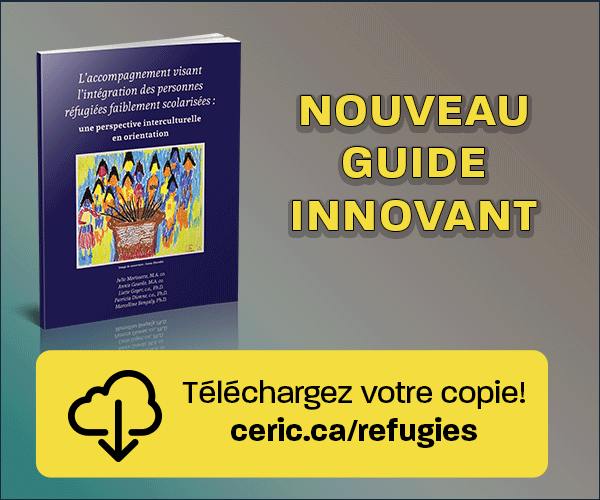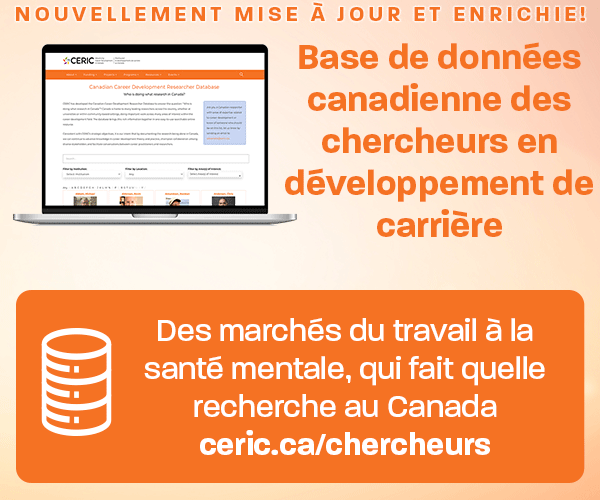Risques psychosociaux et bien-être subjectif sur le lieu de travail au Canada
chevauchement de l'exposition aux risques, de l'éthique professionnelle et de la résilience
DOI :
https://doi.org/10.53379/cjcd.2022.327Mots-clés :
bien-être, risques psychosociaux, précarité, harcèlement, l'éthique du travail, résilienceRésumé
Cet article propose une nouvelle typologie des travailleurs, fondée sur un ensemble amélioré d'indicateurs de risques psychosociaux et de bien-être, et examine les traits de caractère associés à l'appartenance à chaque classe. Cet article innove en prenant simultanément en compte la façon dont les comportements hostiles, les mauvaises conditions de travail et la précarité de l'emploi sont associés à différentes mesures subjectives du bien-être. Cette étude utilise une approche centrée sur la personne en effectuant une analyse de classe latente sur un échantillon représentatif de 5867 employés canadiens. Six clusters distincts sont révélés : "lourdement souffrant", "précaire non comblé", "stressé malsain", "harcelé non comblé", "précaire optimiste" et "non exposé". Cet article montre donc que ce ne sont pas le harcèlement ou le manque d'avantages sociaux en soi qui affectent le bien-être des travailleurs. Il démontre que le bien-être des travailleurs ne se détériore que lorsque des comportements/conflits hostiles et de mauvaises conditions de travail/emploi se superposent. Les résultats suggèrent deux tendances clés: l'exposition superposée à la précarité, à l'injustice procédurale et aux faibles perspectives d'avancement réduit l'éthique du travail, tandis que l'exposition superposée aux comportements/conflits hostiles et à la concurrence réduit la résilience.
Références
Afonso, P., Fonseca, M., & Pires, J. F. (2017). Impact of working hours on sleep and mental health. Occupational Medicine, 67(5), 377-382.
Akaike, H. (1998). Information theory and an extension of the maximum likelihood principle. In Selected papers of Hirotugu Akaike (pp. 199-213). Springer, New York, NY.
Andersson, L. M., & Pearson, C. M. (1999). Tit for tat? The spiraling effect of incivility in the workplace. Academy of Management Review, 24, 452–471.
Bakker, A. B., & Oerlemans, W. (2011). Subjective well-being in organizations. The Oxford Handbook of Positive Organizational Scholarship, 49, 178-189.
Benach, J., Vives, A., Amable, M., Vanroelen, C., Tarafa, G., & Muntaner, C. (2014). Precarious employment: understanding an emerging social determinant of health. Annual Review of Public Health, 35, 229-253.
Benavides, F. G., Benach, J., Diez-Roux, A. V., & Roman, C. (2000). How do types of employment relate to health indicators? Findings from the Second European Survey on Working Conditions. Journal of Epidemiology & Community Health, 54(7), 494-501.
Bérenger, V., & Verdier-Chouchane, A. (2007). Multidimensional measures of well-being: Standard of living and quality of life across countries. World Development, 35(7), 1259-1276.
Blau, G., & Ryan, J. (1997). On measuring work ethic: A neglected work commitment facet. Journal of Vocational Behavior, 51(3), 435-448.
Blustein, D. L., Duffy, R., Ferreira, J. A., Cohen-Scali, V., Cinamon, R. G., & Allan, B. A. (2020). Unemployment in the time of COVID-19: A research agenda. Journal of Vocational Behavior, 119, Article 103436.
Bosmans, K., Lewchuk, W., De Cuyper, N., Hardonk, S., Van Aerden, K., & Vanroelen, C. (2017). The experience of employment strain and activation among temporary agency workers in Canada. Society, Health & Vulnerability, 8(1), Article 1306914.
Boxall, P., & Macky, K. (2014). High-involvement work processes, work intensification and employee well-being. Work, Employment and Society, 28(6), 963-984.
De Dreu, C. K., Van Dierendonck, D., & Dijkstra, M. T. (2004). Conflict at work and individual well‐being. International Journal of Conflict Management. 15(1), 6-26.
Deitch, E. A., Barsky, A., Butz, R. M., Chan, S., Brief, A. P., & Bradley, J. C. (2003). Subtle yet significant: The existence and impact of everyday racial discrimination in the workplace. Human Relations, 56(11), 1299-1324.
De Witte, H., Pienaar, J., & De Cuyper, N. (2016). Review of 30 years of longitudinal studies on the association between job insecurity and health and well‐being: Is there causal evidence? Australian Psychologist, 51(1), 18-31.
Einarsen, S. V., Hoel, H., Zapf, D., & Cooper, C. L. (Eds.). (2020). Bullying and Harassment in the Workplace: Theory, Research and Practice. CRC Press.
Fletcher, T. D., Major, D. A., & Davis, D. D. (2008). The interactive relationship of competitive climate and trait competitiveness with workplace attitudes, stress, and performance. Journal of Organizational Behavior, 29(7), 899-922.
Franklin, P., & Gkiouleka, A. (2021). A Scoping Review of Psychosocial Risks to Health Workers During the Covid-19 Pandemic. International Journal of Environmental Research and Public Health, 18(5), 2453.
Furnham, A. (1984). The Protestant work ethic: A review of the psychological literature. European Journal of Social Psychology, 14(1), 87-104.
Gaitens, J., Condon, M., Fernandes, E., & McDiarmid, M. (2021). Covid-19 and essential workers: A narrative review of health outcomes and moral injury. International Journal of Environmental Research and Public Health, 18(4), 1446.
Gevaert, J., Van Aerden, K., De Moortel, D., & Vanroelen, C. (2020). Employment quality as a health determinant: Empirical evidence for the waged and self-employed. Work and Occupations, 48(2), 146-183.
Goh, Z., Ilies, R., & Wilson, K. S. (2015). Supportive supervisors improve employees’ daily lives: The role supervisors play in the impact of daily workload on life satisfaction via work–family conflict. Journal of Vocational Behavior, 89, 65-73.
Hango, D., & Moyser, M. (2018). Harassment in Canadian workplaces. Insights on Canadian Society. December. Statistics Canada Catalogue no. 75-006-X.
Hartmann, S., Weiss, M., Newman, A., & Hoegl, M. (2020). Resilience in the workplace: A multilevel review and synthesis. Applied Psychology, 69(3), 913-959.
Häusser, J. A., Mojzisch, A., Niesel, M., & Schulz-Hardt, S. (2010). Ten years on: A review of recent research on the Job Demand–Control (-Support) model and psychological well-being. Work & Stress, 24(1), 1-35.
Hershcovis, M. S., & Barling, J. (2010). Towards a multi‐foci approach to workplace aggression: A meta‐analytic review of outcomes from different perpetrators. Journal of Organizational Behavior, 31(1), 24-44.
Huang, Y., Chua, T. C., Saw, R. P., & Young, C. J. (2018). Discrimination, bullying and harassment in surgery: a systematic review and meta-analysis. World Journal of Surgery, 42(12), 3867-3873.
Inanc, H. (2020). Varieties of precarity: How insecure work manifests itself, affects well-being, and is shaped by social welfare institutions and labor market policies. Work and Occupations, 47(4), 504-511.
Johnson, G. J., & Johnson, W. R. (1996). Perceived overqualification and psychological well-being. The Journal of Social Psychology, 136(4), 435-445.
Kalliath, T., & Brough, P. (2008). Work-life balance: A review of the meaning of the balance construct. Journal of Management & Organization, 14(3), 323-327.
Karasek R.A. (1979). Job demands, job decision latitude, and mental strain: Implications for job redesign. Administrative Science Quarterly, 24(2), 285-308.
Khan, K., Abbas, M., Gul, A., & Raja, U. (2015). Organizational justice and job outcomes: Moderating role of Islamic work ethic. Journal of Business Ethics, 126(2), 235-246.
Knudsen, H., Busck, O., & Lind, J. (2011). Work environment quality: The role of workplace participation and democracy. Work, Employment and Society, 25(3), 379-396.
Krieger, N. (2014). Discrimination and health inequities. International Journal of Health Services, 44(4), 643-710.
Leon-Perez, J. M., Notelaers, G., Arenas, A., Munduate, L., & Medina, F. J. (2014). Identifying victims of workplace bullying by integrating traditional estimation approaches into a latent class cluster model. Journal of Interpersonal Violence, 29(7), 1155-1177.
Lewchuk, W., De Wolff, A., King, A., & Polanyi, M. (2003). From job strain to employment strain: Health effects of precarious employment. Just Labour, 3(Fall): 23–35
Leymann, H. & Gustafsson, A. (1996). Mobbing at Work and the Development of Post-Traumatic Stress Disorders. European Journal of Work and Organizational Psychology, 5(2), 251-275.
Leymann, H. (1996). The content and development of mobbing at work. European Journal of Work and Organizational Psychology, 5(2), 165-184.
Mackenbach, J. P., Stirbu, I., Roskam, A. J. R., Schaap, M. M., Menvielle, G., Leinsalu, M., & Kunst, A. E. (2008). Socioeconomic inequalities in health in 22 European countries. New England Journal of Medicine, 358(23), 2468-2481.
Martens, M. F. J., Nijhuis, F. J., Van Boxtel, M. P., & Knottnerus, J. A. (1999). Flexible work schedules and mental and physical health. A study of a working population with non‐traditional working hours. Journal of Organizational Behavior: The International Journal of Industrial, Occupational and Organizational Psychology and Behavior, 20(1), 35-46.
Mayerl, H., Stolz, E., Waxenegger, A., & Freidl, W. (2017). Exploring differential health effects of work stress: a latent class cluster approach. PeerJ, 5, e3106.
Mossey, J. M., & Shapiro, E. (1982). Self-rated health: a predictor of mortality among the elderly. American Journal of Public Health, 72(8), 800-808.
Neault, R.A. (2002). Thriving in the New Millennium: Career Management in the Changing World of Work. Canadian Journal of Career Development, 1(1), 10-21.
Notelaers, G., Einarsen, S., De Witte, H., & Vermunt, J. K. (2006). Measuring exposure to bullying at work: The validity and advantages of the latent class cluster approach. Work & Stress, 20(4), 289-302.
Notelaers, G., Van der Heijden, B., Guenter, H., Nielsen, M. B., & Einarsen, S. V. (2018). Do interpersonal conflict, aggression and bullying at the workplace overlap? A latent class modeling approach. Frontiers in Psychology, 9, Article 1743.
Pavalko, E. K., Mossakowski, K. N., et Hamilton, V. J. (2003). Does perceived discrimination affect health? Longitudinal relationships between work discrimination and women’s physical and emotional health. Journal of Health and Social Behavior, 44(1), 18-33.
Peckham, T., Fujishiro, K., Hajat, A., Flaherty, B. P., & Seixas, N. (2019). Evaluating employment quality as a determinant of health in a changing labor market. RSF: The Russell Sage Foundation Journal of the Social Sciences, 5(4), 258-281.
Pettigrew, T. F., & Martin, J. (1987). Shaping the organizational context for Black American inclusion. Journal of Social Issues, 43(1), 41-78.
Petts, R. J., Carlson, D. L., & Pepin, J. R. (2020). A Gendered Pandemic: Childcare, Homeschooling, and Parents’ Employment During COVID‐19. Gender, Work & Organization, 1-20.
Prado-Gascó, V., Gómez-Domínguez, M. T., Soto-Rubio, A., Díaz-Rodríguez, L., & Navarro-Mateu, D. (2020). Stay at Home and Teach: A Comparative Study of Psychosocial Risks Between Spain and Mexico During the Pandemic. Frontiers in Psychology, 11, 2576.
Rees, C. S., Breen, L. J., Cusack, L., & Hegney, D. (2015). Understanding individual resilience in the workplace: the international collaboration of workforce resilience model. Frontiers in Psychology, 6, 73.
Rigó, M., Dragano, N., Wahrendorf, M., Siegrist, J., & Lunau, T. (2020). Work stress on rise? Comparative analysis of trends in work stressors using the European working conditions survey. International Archives of Occupational and Environmental Health, 94(3), 1-15.
Roberts, R. K., Swanson, N. G., & Murphy, L. R. (2004). Discrimination and occupational mental health. Journal of Mental Health, 13(2), 129-142.
Sahai, S., Ciby, M. A., & Kahwaji, A. T. (2020). Workplace isolation: a systematic review and synthesis. International Journal of Management, 11(12), 2745-2758.
Savage, M., Devine, F., Cunningham, N., Taylor, M., Li, Y., Hjellbrekke, J., Le Roux, B., Friedman, S. & Miles, A. (2013). A new model of social class? Findings from the BBC’s Great British Class Survey experiment. Sociology, 47(2), 219-250.
Schilpzand, P., De Pater, I. E., & Erez, A. (2016). Workplace incivility: A review of the literature and agenda for future research. Journal of Organizational Behavior, 37, S57-S88.
Schmitt, M., & Dörfel, M. (1999). Procedural injustice at work, justice sensitivity, job satisfaction and psychosomatic well‐being. European Journal of Social Psychology, 29(4), 443-453.
Schwarz, G. (1978). Estimating the dimension of a model. Annals of Statistics, 6(2), 461-464.
Sloan, M. (2012). Unfair treatment in the workplace and worker well-being: The role of coworker support in a service work environment. Work and Occupations, 39(1), 3-34.
Song, Y., & Gao, J. (2020). Does telework stress employees out? A study on working at home and subjective well-being for wage/salary workers. Journal of Happiness Studies, 21(7), 2649-2668.
Sparks, K., Cooper, C., Fried, Y. and Shirom, A. (1997). The effects of hours of work on health: a metaanalytic review. Journal of Occupational & Organizational Psychology, 70(4), 391–408.
Stansfeld, S., & Candy, B. (2006). Psychosocial work environment and mental health—a meta-analytic review. Scandinavian Journal of Work, Environment & Health, 32(6), 443-462.
Sullivan, C., & Lewis, S. (2001). Home-based telework, gender, and the synchronization of work and family: perspectives of teleworkers and their co-residents. Gender, Work & Organization, 8(2), 123-145.
Sverke, M., Hellgren, J. and Näswall, K. (2002). No security: a meta-analysis and review of job insecurity and its consequences. Journal of Occupational Health Psychology, 7(3), 242–264.
Tavares, A. I. (2017). Telework and health effects review. International Journal of Healthcare, 3(2), 30.
Theorell, T., Hammarström, A., Aronsson, G., Bendz, L. T., Grape, T., Hogstedt, C., & Hall, C. (2015). A systematic review including meta-analysis of work environment and depressive symptoms. BMC Public Health, 15(1), 738.
Van Aerden, K., Gadeyne, S., & Vanroelen, C. (2017). Is any job better than no job at all? Studying the relations between employment types, unemployment and subjective health in Belgium. Archives of Public Health, 75(1), 1-10.
Van Aerden, K., Puig-Barrachina, V., Bosmans, K., & Vanroelen, C. (2016). How does employment quality relate to health and job satisfaction in Europe? A typological approach. Social Science & Medicine, 158, 132-140.
Vanroelen, C., Louckx, F., Moors, G., & Levecque, K. (2010). The clustering of health-related occupational stressors among contemporary wage-earners. European Journal of Work and Organizational Psychology, 19(6), 654-674.
Wagnild, G. M., & Young, H. M. (1993). Development and psychometric. Journal of nursing measurement, 1(2), 165-178.
Wang, M., & Hanges, P. J. (2011). Latent class procedures: Applications to organizational research. Organizational Research Methods, 14(1), 24-31.
Wanous, J. P., Reichers, A. E., & Hudy, M. J. (1997). Overall job satisfaction: how good are single-item measures? Journal of applied Psychology, 82(2), 247-252.
Zaka, A., Shamloo, S. E., Fiorente, P., & Tafuri, A. (2020). COVID-19 pandemic as a watershed moment: A call for systematic psychological health care for frontline medical staff. Journal of Health Psychology, 25(7): 883-887.

Téléchargements
Publié-e
Comment citer
Numéro
Rubrique
Licence
(c) Tous droits réservés La Revue canadienne de développement de carrière 2022

Cette œuvre est sous licence Creative Commons Attribution - Pas d'Utilisation Commerciale - Pas de Modification 4.0 International.











